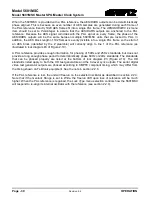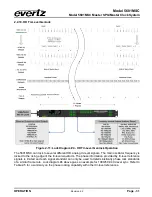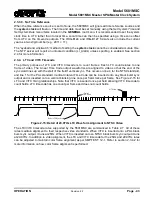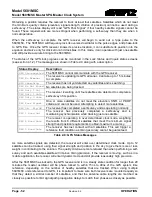
Model 5601MSC
Model 5601MSC Master SPG/Master Clock System
Page - 44
Revision 2.2
OPERATION
Name
Counting
Rate
Frame
counts
per second
Time to
count one
frame
Time to count
one second
worth of frames
Number of frame
counts in a 24-
hour period
Color
frame
Alignment
23.98 FPS
24/1.001 Hz
24
41.708 ms
1.001 seconds
2,073,600
No
24 FPS
24 Hz
24
41.67 ms
1 second
2,073,600
No
25 FPS
25 Hz
25
40 ms
1 second
2,160,000
PAL
29.97 FPS
30/1.001 Hz
30
33.367 ms
1.001 seconds
2,592,000
NTSC
29.97DF FPS 30/1.001 Hz
30
33.367 ms
1.001 seconds
2,589,408
NTSC
30 FPS
30 Hz
30
33.33 ms
1 second
2,592,000
No
Table 2-7: Supported LTC Frame Rates Summary
Relating LTC/VITC frame counts to real time can get quite complex. The LTC rates of 24Hz and 30Hz
run at real-time and do not suffer from color frame alignment rules. They take exactly one second to
reach their full count of either 24 or 30 frames. The 25Hz rate also runs at real-time but may be
adjusted to maintain color frame alignment to PAL video (see section 2.3.4.2.3 for the implications of
this).
The 23.98Hz and 29.97Hz rates run slightly slower than real-time. They take slightly longer than one
second (1.001 seconds) to count a full second worth of frames. This means that every minute they will
lag behind real-time by 0.06 seconds. Every hour they will be behind 3.6 seconds. After a 24-hour
period they will be 86.4 seconds behind real-time. These rates are unsuitable for timekeeping purposes.
They are only useful for counting frames.
2.3.4.1. Dropframe Counting
Because the 29.97Hz rate is used extensively as timecode for video reference signals, a method was
developed to allow reasonably precise time keeping with the non real-time rate. This method involves
dropframe counting. Since the 29.97Hz rate runs slower than real-time, dropframe counting skips over
certain frame counts in order to periodically catch up to real time. Frame counts are always skipped
over in pairs so as not to disrupt any color frame alignment. Two frame counts are skipped over at the
beginning of every minute, except minutes 00, 10, 20, 30, 40, and 50. This pattern can be seen in
Figure 2-16.
Dropframe counting ensures that 29.97Hz timecode accumulates just 86.4 milliseconds of error per day
and always stays within 200 milliseconds of real-time. Figure 2-17 illustrates the drift and catch-up cycle
that dropframe counting goes through over the course of a day. Real-time is represented by the solid X-
axis in the graphs. See section 2.3.4.2.2 for information on synchronizing multiple dropframe timecode
outputs.
To maintain a long-term correlation to real time, all LTC and VITC timecode outputs are
jammed
to the
system clock
once per day. This limits the amount of accumulated error for non real-time rates. Daily
jamming is also required for real-time rates to prevent accumulation of stability errors and to keep
synchronized should a leap second occur. The time at which this daily jam occurs is controlled by the
Jam Time
menu item present in all LTC and sync output menus. The daily
jam
should be scheduled to
occur at a time when it would be least likely to affect system operation. The timecode clock will
jam
when the LTC or VITC timecode count matches the
Jam Time
value.
















































